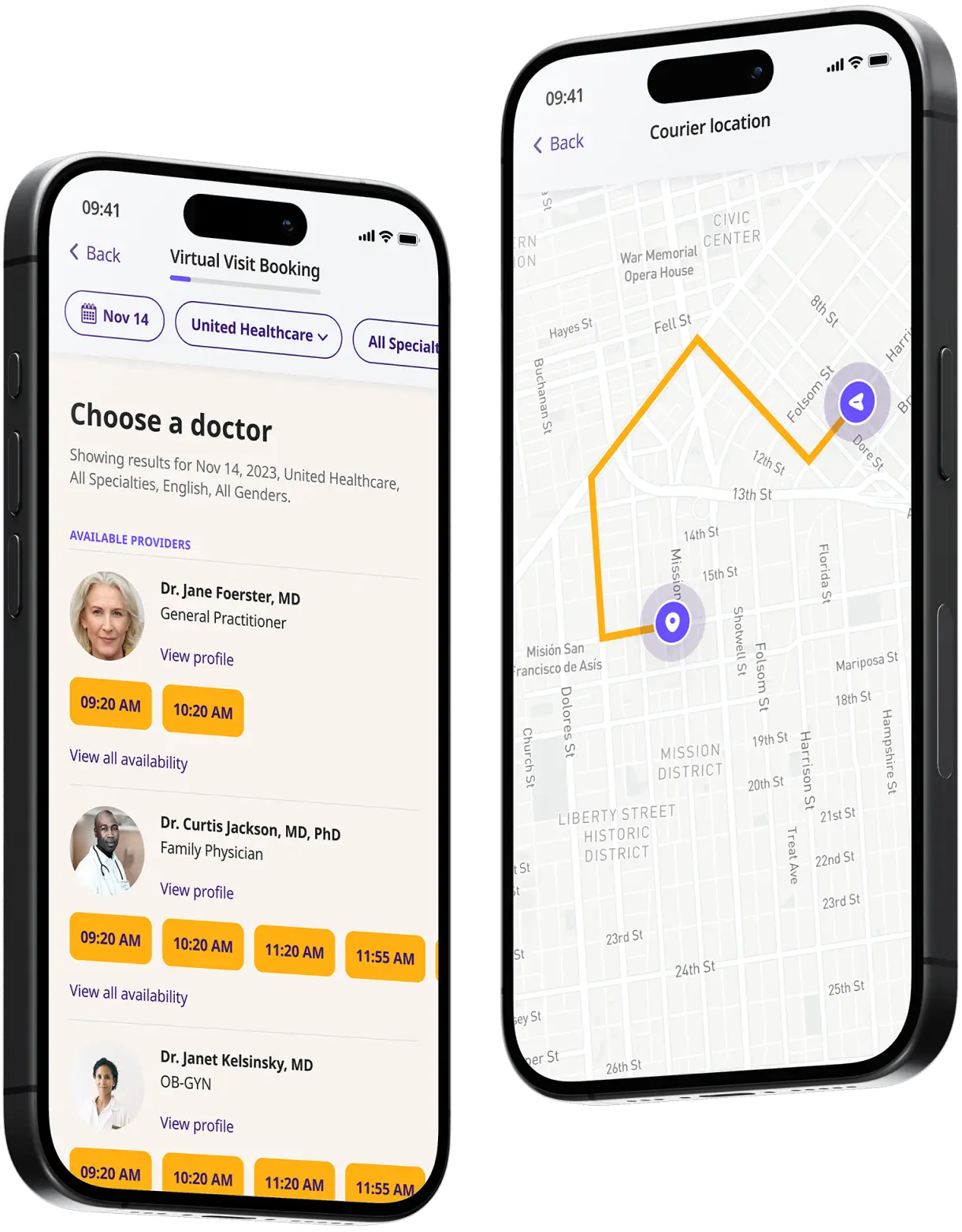Psoriasis Treatment Online
24/7 expert advice and treatment from DrHouse online doctors.


Available in 50 states. Insurance accepted.
Fast
virtual visits
24/7 care
assistants
Prescriptions
as needed

24/7 Personal Care
Consult with a physician in 15 minutes, refill an Rx or chat with our care assistants.

Affordable & Convenient
See your cost upfront and get treatment for hundreds of different conditions.

Insurance Accepted
We accept most major insurance plans, making healthcare easy and affordable.
See If Delivery Is Available Near You
Delivery Not Available
Enter your ZIP code to check if prescription delivery is available in your area and how soon your meds could arrive.
How to get started
Choose your doctor, start a virtual visit, and have your prescriptions sent to your preferred pharmacy for pickup — all in just a few easy steps.
Choose a doctor
Choose a physician by availability, specialty, ratings, and more.

Start your video visit
Connect with a doctor in minutes on a secure video call.

Get your prescription
Pick up your meds or have them delivered in as little as an hour.

Available in 50 states. Insurance accepted.
One-Time
Physician Visit
One-time visit with a physician for diagnosis, treatment, Rx, labs, referrals, and doctor’s notes.
Accepted Insurances
See why people turn to DrHouse...
As seen in

About Psoriasis
What is psoriasis?
Psoriasis is a skin condition that causes red, scaly patches on the skin. It is an autoimmune disease where the immune system mistakenly attacks healthy skin cells, causing them to grow too quickly and form thick, silvery scales.
Psoriasis can occur anywhere on the body but most commonly appears on the scalp, elbows, knees, and lower back.
Types of psoriasis
There are several types of psoriasis, each with its own characteristics and severity. These include:
- Plaque psoriasis (psoriasis vulgaris): This is the most common form of psoriasis, affecting about 80% to 90% of people with the condition. It features raised, inflamed, red lesions covered by silvery-white scales. These plaques usually appear on the scalp, knees, elbows, and lower back.
- Guttate psoriasis: Guttate psoriasis is characterized by small, water-drop-shaped, scaling lesions on the trunk, arms, legs, and scalp. It is often triggered by a bacterial infection such as strep throat and is more common in children and young adults.
- Inverse psoriasis: Also known as intertriginous psoriasis, this type appears as bright red, smooth, and shiny lesions that occur in skin folds, such as under the breasts, in the groin, under the armpits, or around the genitals and buttocks. Friction and sweating can worsen the condition.
- Pustular psoriasis: Pustular psoriasis is marked by white pustules (blisters of non-infectious pus) surrounded by red skin. The pus consists of white blood cells. It can be localized to certain areas of the body, such as the hands and feet (palmoplantar pustulosis), or it can cover most of the body, which is a rarer and more severe form known as generalized pustular psoriasis.
- Erythrodermic psoriasis: This is the least common type of psoriasis and can cover your entire body with a red, peeling rash that can itch or burn intensely. It is a severe form of psoriasis that can be life-threatening, especially if it leads to heart failure or pneumonia.
- Nail psoriasis: Nail psoriasis affects the fingernails and toenails, causing pitting, abnormal nail growth, and discoloration. Nails may become loose and separate from the nail bed (onycholysis). Severe cases may cause the nail to crumble.
- Psoriatic arthritis: Psoriatic arthritis is a condition where individuals have both psoriasis and arthritis (joint inflammation). This can affect any joints but most commonly affects the hands, feet, knees, neck, and lower back. The symptoms can range from mild to severe and can lead to permanent joint damage.
Psoriasis symptoms
The symptoms of psoriasis vary depending on the type and severity of the condition, but some common symptoms include:
- Plaques of red skin: These are often covered with silver-white scales and are the most common symptom of plaque psoriasis. These plaques might be itchy and painful and can crack and bleed.
- Small scaling spots: Particularly seen in children, these are typical of guttate psoriasis.
- Dry, cracked skin: This may bleed and can be quite painful. It may also be accompanied by a burning sensation.
- Itching, burning, or soreness: These sensations are common in areas affected by psoriasis.
- Thickened, pitted, or ridged nails: Nail psoriasis can cause abnormal nail growth and discoloration.
- Swollen, stiff, or painful joints: This is a common symptom of psoriatic arthritis, a type of inflammatory arthritis associated with psoriasis.
- Severe dandruff on the scalp: This can range from slight, fine flaking to thick, adherent scales.
- Red patches in skin folds: Inverse psoriasis can cause smooth, red patches in the skin folds.
The intensity of psoriasis symptoms can vary, with flare-ups followed by periods of remission. Factors such as stress, infections, or certain medications can trigger flare-ups.
Psoriasis causes
The exact cause of psoriasis is still unknown, but it is believed to be a combination of genetic and environmental factors. The immune system plays a significant role in the development of psoriasis, with T cells (a type of white blood cell) mistakenly targeting healthy skin cells.
This leads to an increase in the production of skin cells, causing the characteristic red, scaly patches to form.
Factors that may also contribute to the development of psoriasis include:
- Genetics: Having a family history of psoriasis increases your risk of developing the condition.
- Infections: Strep throat, skin infections, and respiratory infections can trigger guttate psoriasis in some individuals.
- Skin injuries: Psoriasis may develop at the site of a skin injury, such as a cut, scratch, or sunburn.
- Medications: Certain medications, such as lithium (used to treat bipolar disorder), beta-blockers (used to treat high blood pressure), and antimalarial drugs can trigger psoriasis in some people.
- Stress: Stress can worsen existing psoriasis or trigger flare-ups.
Psoriasis is also associated with other conditions such as:
- Type 2 diabetes
- Hearth and cardiovascular disease
- Depression and anxiety
- Obesity
- Anxiety and depression
Treatment of psoriasis
While there is currently no cure for psoriasis, there are treatment options available to manage and control the symptoms. These include:
- Topical treatments: Creams, lotions, ointments, and shampoos applied directly to the skin can help reduce inflammation and soothe symptoms.
- Phototherapy: This involves exposing the affected skin to controlled amounts of natural or artificial ultraviolet light, which can slow down the production of skin cells.
- Systemic medications: For more severe cases, oral or injected medications that target the immune system may be prescribed. These include biologics, immunosuppressants, and retinoids.
- Lifestyle changes: Adopting a healthy lifestyle by managing stress levels, maintaining a healthy weight, and avoiding triggers can help control psoriasis symptoms.
When to get medical help?
If you suspect that you may have psoriasis, you should consult with a doctor for an accurate diagnosis and appropriate treatment. Psoriasis is a chronic condition that requires long-term management, and early diagnosis and treatment can help prevent severe symptoms.
Related services
Explore more of our services tailored to your needs and discover additional ways we can support your healthcare needs.
Frequently asked questions




